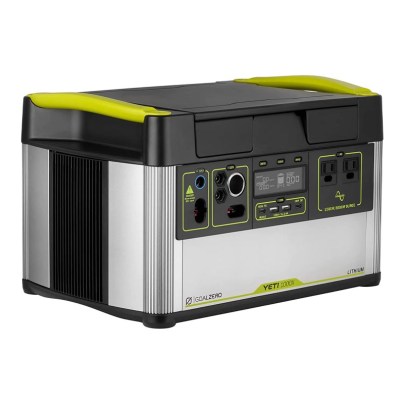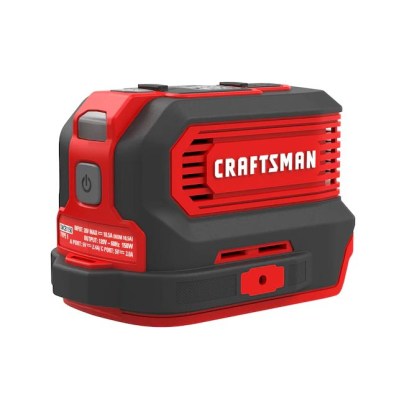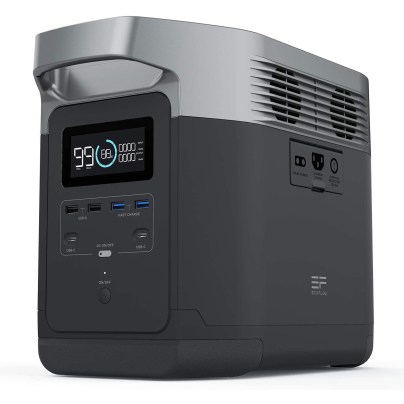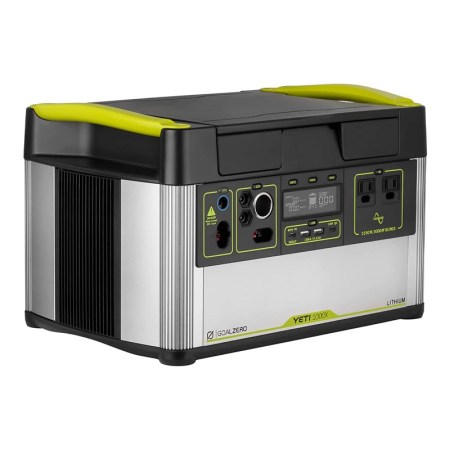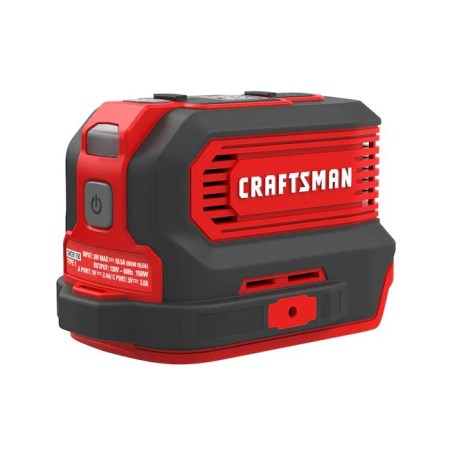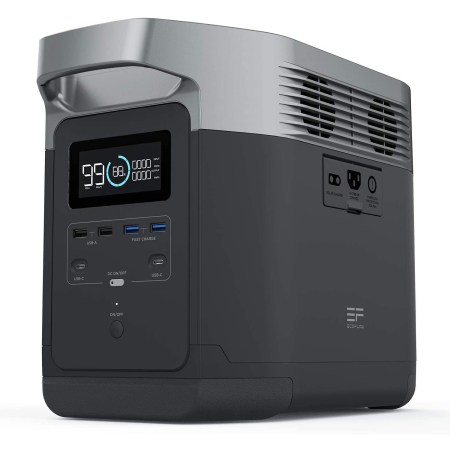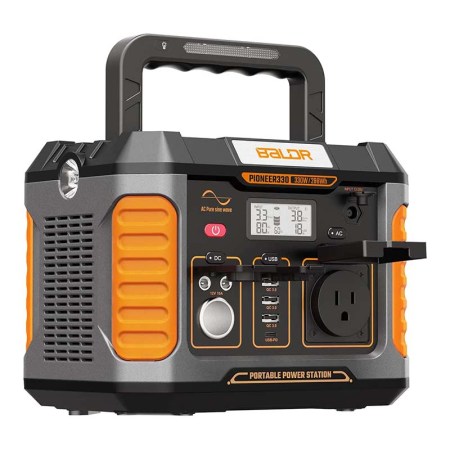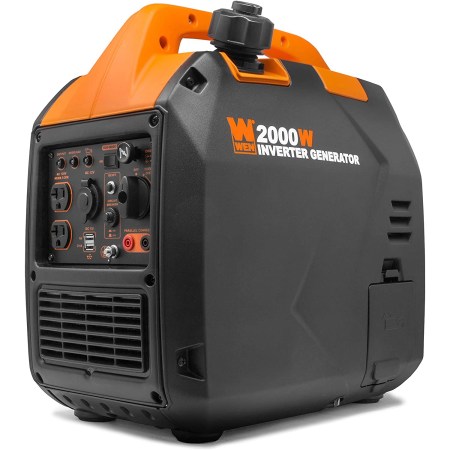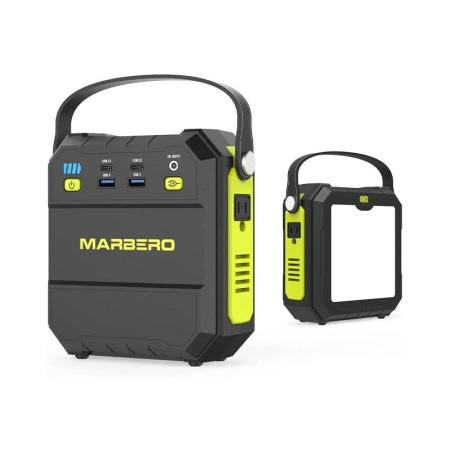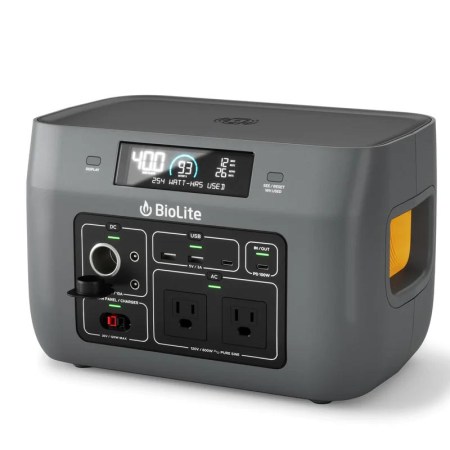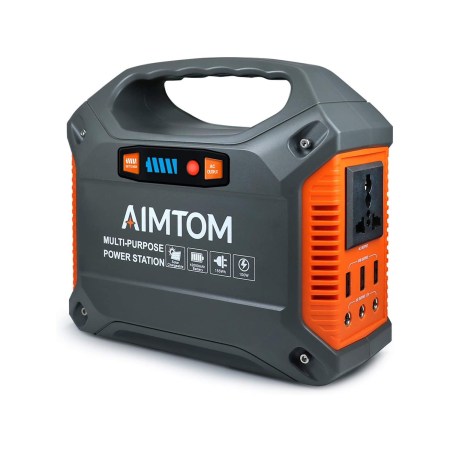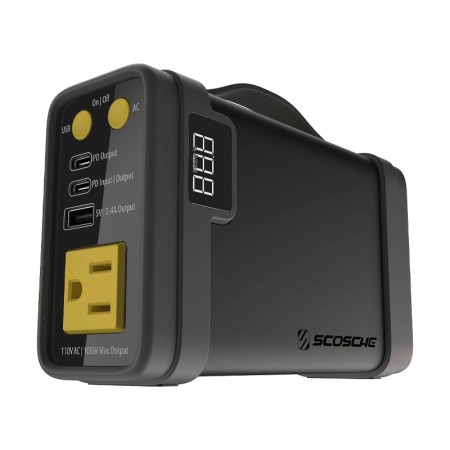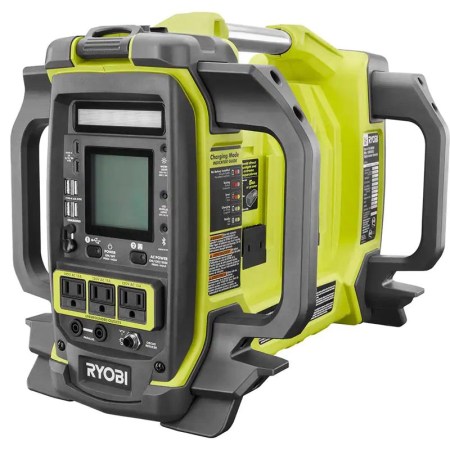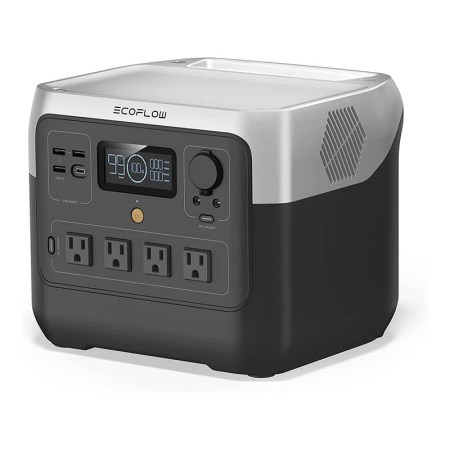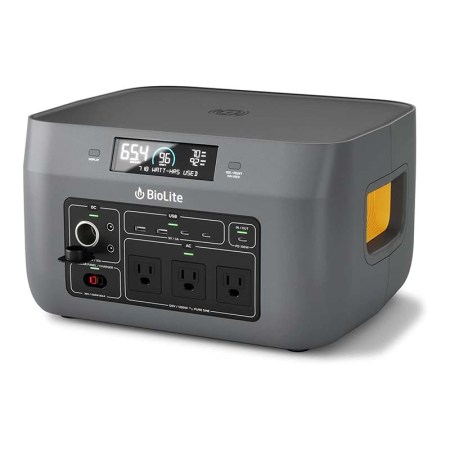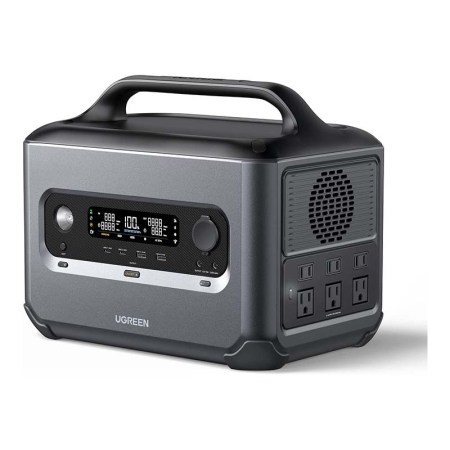We may earn revenue from the products available on this page and participate in affiliate programs. Learn More ›
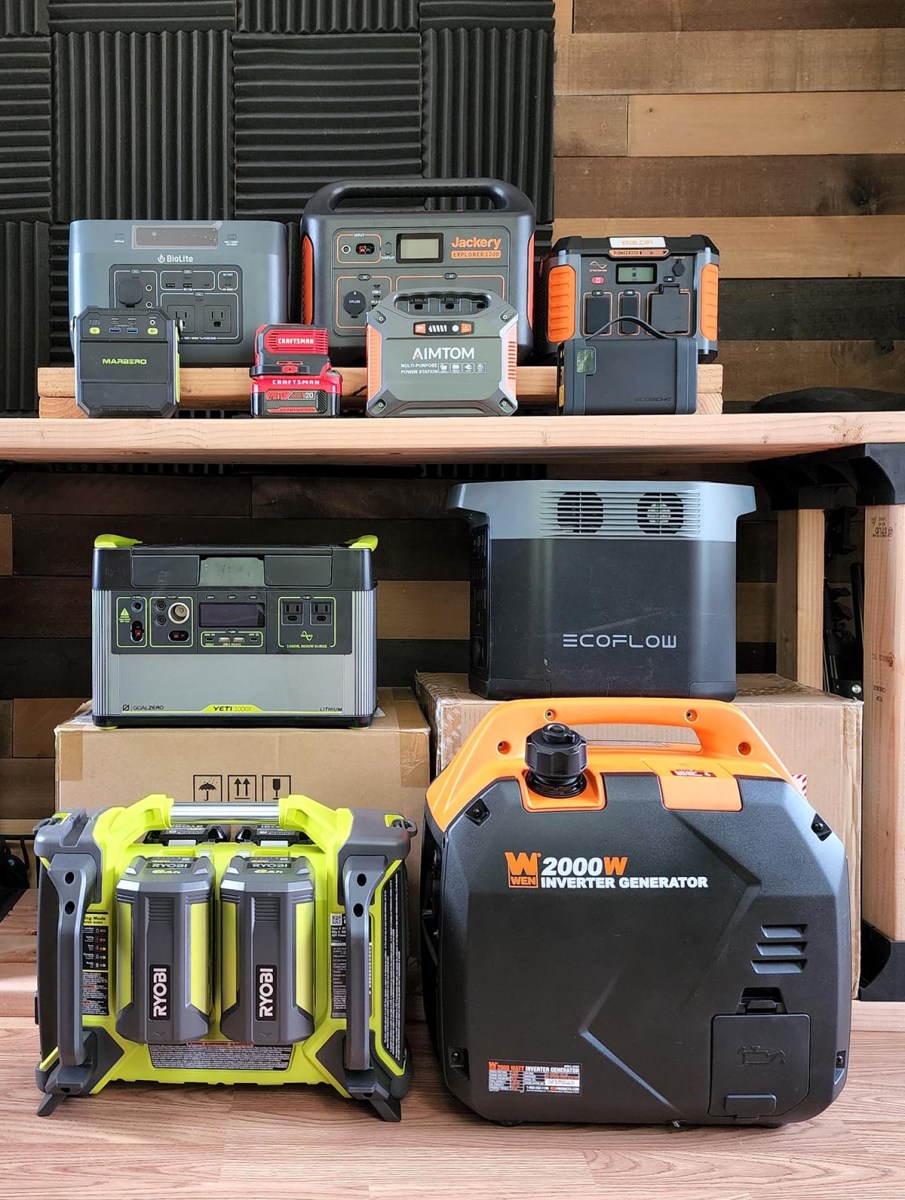
A portable power station stores an electrical charge in an internal battery to charge various devices, such as a tablet, phone, or flashlight. You can charge these portable power supplies in several ways, including using a solar panel, a standard electrical outlet, or even a gas-powered inverter generator.
The best portable power stations for camping trips, storms, and outages vary depending on the power output, charging capacity, and preferred energy source. Take a look at the following options for an emergency power station or portable energy supply. Read our portable power station reviews on the top models below, along with important factors to consider before selecting the best portable power station.
And, to help, we put the top-rated power stations through hands-on testing. We spent hours with some of the smaller models and days with some of the larger ones. We even took some on road trips to baseball tournaments and other events. Keep reading to learn more about what we found from the following models.
- BEST OVERALL: Goal Zero Yeti 1000X Portable Power Station
- BEST BANG FOR THE BUCK: Craftsman V20 150-Watt Power Inverter
- UPGRADE PICK: EcoFlow Delta Portable Power Station
- BEST ELECTRIC: Baldr P330 Portable Power Station
- BEST GAS-POWERED: Wen 56203i Super Quiet 2000-Watt Portable Inverter
- BEST SOLAR: Jackery Explorer 1000 Portable Power Station
- BEST LIGHTWEIGHT: Marbero M87 Portable Power Station
- BEST FOR DEVICES: BioLite BaseCharge 600 Rechargeable Power Station
- BEST COMPACT: Aimtom PowerPal X Portable Power Station
- BEST FOR TRAVEL: Scosche PowerUp 32K Portable Power Station
- BEST REPLACEABLE BATTERIES: Ryobi 1800-Watt Portable Power Station Kit
- BEST FOR ROAD TRIPS: EcoFlow River 2 Pro Portable Power Station
- BEST OFF-GRID: BioLite BaseCharge 1500 Rechargeable Power Station
- BEST QUICK-CHARGING: Ugreen 1200W Portable Power Station
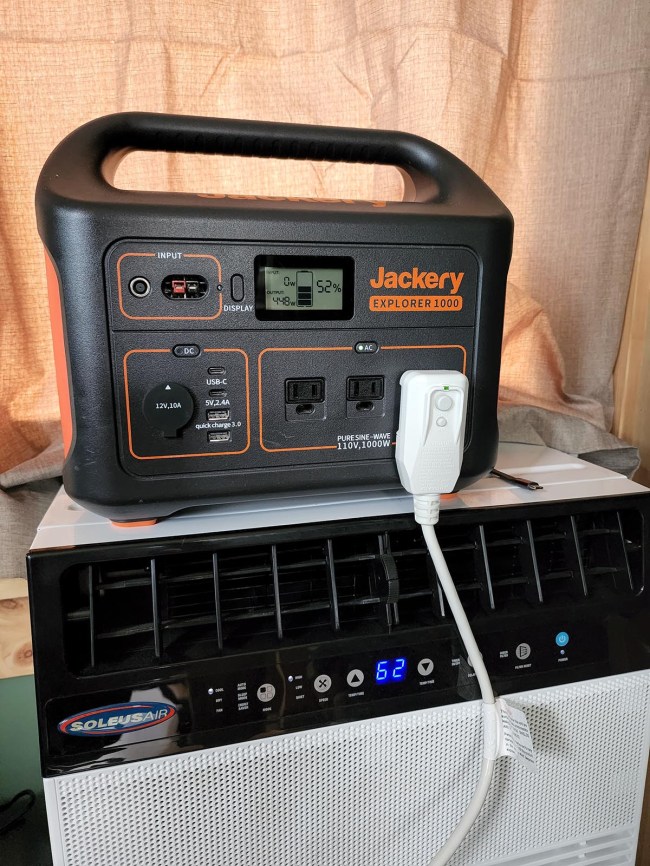
How We Tested the Best Portable Power Stations
We wanted to ensure that we were only suggesting the best power station for each award. We developed a series of tests and trials to put these power stations through, taking note of their performance at each step.
We used the smaller power stations to charge devices like our phones and laptops, paying close attention to how quickly they drained relative to the speed at which the devices filled. We also ran a desk fan and a lamp off of each model (separately, as they each only had one standard outlet). We compared these models based on size and portability, ranking them by weight and size.
The tests were quite different for the larger models. The timing of this test was good, since the transformer at the end of the street blew five times within 2 weeks after receiving the models. They all saw work as an emergency power station, keeping refrigerators, TVs, routers, lights, and household devices up and running.
We also tested the larger models with the most power-hungry appliances we could think of: an air conditioner and a space heater. We waited for a 90-degree-Fahrenheit day and cranked our window air conditioner to its coldest temperature setting and highest fan setting. We then did the same for the space heater (talk about energy consumption). We noted how quickly each model drained and which models (there was just one, but we mentioned it below) weren’t able to handle the compressor kicking on.
The results of all these tests gave us the background we needed. We could assemble a list of the best power stations, giving each model that passed an award based on its strengths.
Our Top Picks
The following products rank among the best portable power stations in terms of quality, dependability, and price. Take a look and see some of the models we loved most.
Best Overall
Goal Zero Yeti 1000X Portable Power Station
See ItFolks looking for a versatile power station solution will want to consider the Goal Zero Yeti 1000X portable power station. This model provides 983 watt-hours of power and offers a maximum output of 1,500 watts, ensuring there is enough power on tap for any need. It can handle everything from charging devices off-grid to running refrigerators or air conditioners at home.
This model from Goal Zero features two standard 120-volt outlets, two USB-C outlets, two USB outlets, and several 12-volt outlets. It also has solar inputs, allowing it to charge with solar panels (not included in our kit). It comes with the base model and an 8-millimeter charging port, and it charges from a standard 120-volt outlet in 9 hours. However, you can build upon the Yeti 1000X with home expansion kits and power banks to serve as a home backup as well.
If we’re being totally up front, we didn’t expect to love the Yeti during our testing. There were other models that we were more excited to test. However, this model’s digital display and power won us over. It had no problem powering our air conditioner, power tools, and devices. We even used it to charge some of our smaller power stations, all the while tracking their draw and the battery level. After all that, we learned about all of the available expansion kits, and we couldn’t help but appreciate this model for its possibilities. One thing we didn’t appreciate? It is very heavy.
Product Specs
- Wattage: 1,500 watts
- Dimensions: 12.7 inches high by 18.1 inches wide by 13.1 inches deep
- Weight: 37 pounds
- Outlets: 2 standard, 2 USB, 2 USB-C, and 4 12-volt outlets
- Power storage: 938 watt-hours
Pros
- Plenty of power
- Expansion possibilities for the entire home
- Digital display provides real-time information
Cons
- It is heavy and difficult to transport easily
Get the Goal Zero portable power station at Amazon, The Home Depot, or REI.
Best Bang For The Buck
Craftsman V20 150-Watt Power Inverter
See ItCraftsman blends affordability with portability and sprinkles a bit of capability on top with its 150-watt power inverter. This budget-minded model snaps onto any 20-volt battery from Craftsman, turning it into a compact power supply that you can take anywhere or store in a tool box.
This power inverter features three ports: USB, USB-C, and a standard outlet. It also has a built-in work light to shed a bit of light on a workbench. Runtime will be determined by the size of the battery it’s on, but with a 150-watt output, it can handle lamps, cell phones, and other devices.
In our opinion, this affordable little inverter is ideal for the jobsite. It can quickly turn any 20-volt Craftsman battery into a power station, allowing folks to charge their phones, power drop lights, or even a laptop when there isn’t a battery source nearby. Is it full of possibilities? Not quite, as it’s limited to the battery it’s attached to, but we think anyone with Craftsman batteries ought to consider adding it to their tool box for its convenience and affordability alone.
Product Specs
- Wattage: 150 watts
- Dimensions: 4 inches high by 2.5 inches wide by 3 inches deep
- Weight: Depends on the battery it’s attached to
- Outlets: 1 standard outlet, 1 USB, and 1 USB-C
- Power storage: Depends on the battery
Pros
- Compact design fits in a tool box
- Uses 20-volt Craftsman batteries
- Includes a standard outlet
Cons
- Storage depends on the battery it’s attached to
Get the Craftsman portable power station at Ace Hardware or Lowe’s.
Upgrade Pick
EcoFlow Delta Portable Power Station
See ItEcoFlow’s premium-priced Delta portable power station offers the high power of a gas-powered generator without the noise and harmful fumes. It features an impressive maximum power output of 350,000 milliamp hours (mAh) and charges from 0 to 80 percent in 1 hour on a standard AC outlet. A full charge takes less than 2 hours. It also charges on a compatible solar panel (sold separately) or a 12/24-volt port in a vehicle.
The product powers up to 13 devices at once through its six standard AC outlets, four USB-A ports, two USB-C ports, and one 12-volt outlet. EcoFlow’s appliance features a durable reinforced aluminum chassis, rubber grips, and a built-in handle that allows for the transport of the 31-pound unit.
When it comes to possibilities, we found the EcoFlow Delta to be unmatched. Not only does this model offer plenty of portable power on tap, but it also has more outlets than any other model in our test. Plus, it also had excellent features such as Bluetooth capability and an emergency power supply function that allows it to act as switchgear and a generator all in one. We loved the digital display, and the app was easy to use to connect the Delta to our Wi-Fi. It had no problem running our air conditioner or power tools, though ours did show a maintenance light that the owner’s manual or app does not explain.
Product Specs
- Wattage: 3,300 watts
- Dimensions: 15.7 inches high by 8.3 inches wide by 10.6 inches deep
- Weight: 31 pounds
- Outlets: 6 standard AC outlets, 4 USB-A ports, 2 USB-C ports, and a 12-volt outlet
- Power storage: 350,000mAh
Pros
- 350,000mAh power storage
- Achieves a sufficient charge in 1 hour
- Supports up to 13 devices simultaneously
- Multiple charging options
Cons
- Solar panel chargers not included
- Unexplained maintenance symbol
Get the EcoFlow portable power station at Amazon or Lowe’s.
Best Electric
Baldr P330 Portable Power Station
See ItElectric portable power stations, like the Baldr P330, offer several advantages over gas-powered generators that make them ideal for use in the workshop, at home, or on the road. For one, this electric power station runs silently while it charges up or powers electronic devices. What’s more, it does not produce harmful fumes.
A helpful fold-down handle makes it easy to transport the 9-pound station. A built-in flashlight and battery-management system optimize the function of the device. It powers up to nine devices with 66,000mAh of power and one standard AC outlet, three USB ports, one C-type port, three 12-volt outlets, and a wireless charging pad for compatible devices.
During our test, we found the Baldr to be capable of charging smaller devices, power-tool batteries, and our desk fan. We especially liked the wireless charging pad on top of the unit for keeping phones topped off while working at our test bench. It did take us a while to realize that there was a flashlight built into the handle, but that ended up being one of our favorite features. Unfortunately, this power station wasn’t compatible with our solar panels.
Product Specs
- Wattage: 330 watts
- Dimensions: 7.7 inches high by 11.6 inches wide by 8.3 inches deep
- Weight: 9 pounds
- Outlets: 1 standard AC outlet, 3 USB ports, 1 C-type port, and three 12-volt outlets
- Power storage: 66,000mAh
Pros
- Comes with wireless charging pads
- Lightweight at 9 pounds
- Built-in handle (with built-in light!) for portability
Cons
- It wasn’t compatible with our solar panels
Get the Baldr portable power station at Amazon.
Best Gas-Powered
Wen 56203i Super Quiet 2000-Watt Portable Inverter
See ItAn excellent pick for camping or tailgate parties, Wen’s Super Quiet inverter runs for up to 7 hours on a single gallon of gas. The portable power station’s inverter generator puts out up to 400,000mAh at a quiet 51-decibel volume. An automatic fuel shutoff function prevents blockages and reduces wear by ensuring the machine uses the remaining fuel from the carburetor before shutting down. Low-oil and low-fuel shutdown functions help preserve gas. Two standard AC outlets, two USB ports, and one 12-volt outlet power up to five devices.
We had to set our Wen generator up outside, which is really the downfall of this model. And, because it doesn’t store power, it’s not exactly a power station. All that aside, we found this model to be plenty sufficient. It was able to run power tools and charge batteries, and we even used it to recharge some of our power stations. It’s not as quiet as Wen might market it to be, and you need to be prepared to fill it with oil and gasoline before they need it, but this generator could easily keep up with a few appliances in an emergency.
Product Specs
- Wattage: 2,000 watts
- Dimensions: 17.7 inches high by 11.5 inches wide by 17.3 inches inches deep
- Weight: 39 pounds
- Outlets: 2 standard AC outlets, 2 USB ports, and a 12-volt outlet
- Power storage: 400,000mAh
Pros
- 400,000mAh power output
- Supports up to 5 electronics at once
- Automatic shutoff function for gas preservation
- Operates for 7 hours on a tank of gasoline
Cons
- Not for indoor use
- Doesn’t store power
Get the Wen portable power station at Amazon or Target.
Best Solar
Jackery Explorer 1000 Portable Power Station
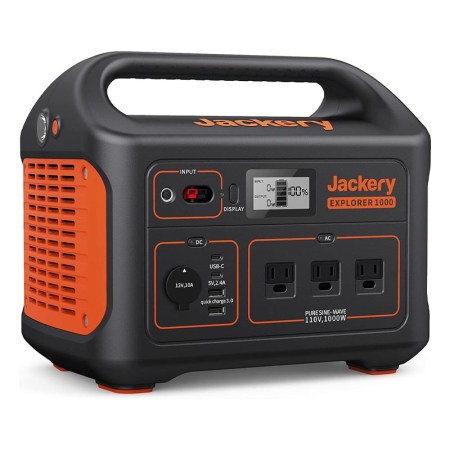
Folks who’d prefer to take their power off-grid, or simply like the idea of a reusable power source, will want to consider the Jackery Explorer 1000 portable power station. This power station is compatible with solar panels and will recharge in about 6 hours with two 100-watt panels in full sun.
The Explorer 1000 features both a 1,000-watt output as well as a 1,002-watt-hour capacity. It has three standard outlets as well as two USB, USB C, and 12-volt DC ports. The digital display keeps you up-to-date on the Explorer’s battery percentage, output, and input. And, for when the power goes out in the middle of the night, the Explorer 1000 has a built-in flashlight to guide the way.
The Jackery Explorer was truly one of our favorite models in the test. We’ve been using this model for over a year now, and it came with two solar panels that are easy to set up and plug into the power station. Also, the Jackery Explorer lasted the longest of all the models in our air-conditioner test, and that’s truly saying something considering it’s been drained and recharged a few times in the past. But, beyond the solar panels and capacity, the Jackery is very easy to use, and the digital display is clean and simple to read. Just keep in mind that solar panels can be expensive.
Product Specs
- Wattage: 1,000 watts
- Dimensions: 11.1 inches high by 13.1 inches wide by 9.2 inches deep
- Weight: 22 pounds
- Outlets: 2 standard, 2 USB, 2 USB C, and a 12-volt DC port
- Power storage: 1,000 watt-hours
Pros
- 1,000 watt-hours and 1,000-watt output
- Compatible with solar panels (ours came with them)
- Easy to set up and use
Cons
- Solar panels are expensive
Get the Jackery portable power station at Amazon or Lowe’s.
Best Lightweight
Marbero M87 Portable Power Station
See ItKeep electronics charged without adding unnecessary weight. At only 2.2 pounds, Marbero’s station makes a great companion on hiking, camping, and road trips (but keep it out of the water). Just grab it by the built-in carrying handle. Making super-efficient use of its light weight, the unit includes a 562-lumen flashlight—one less thing to pack in a backpack. Use it on SOS mode to signal for help in emergencies or simply illuminate the campsite for over 12 hours on a full charge.
When the power station runs out of energy, recharge it with a nearby electrical outlet, plug it into the 12-volt car charger, or use a compatible solar panel (sold separately). Charge up to five devices at one time with the built-in outlets (including one standard AC outlet, two USB-A ports, and two USB-C ports) and 22,500mAh of power output.
The Marbero proved to be a neat little package. First, the light is every bit as bright as it’s made out to be, and that can be a huge boost during a power outage or camping trip. Also, it handled charging our large power-tool batteries without a problem. Our biggest complaint is that it doesn’t have a digital display to detail the input and output or battery life, but it does have a four-LED bar to give a rough estimate of the remaining battery life.
Product Specs
- Wattage: 120 watts
- Dimensions: 5.6 inches high by 5.7 inches wide by 2.7 inches deep
- Weight: 2.2 pounds
- Outlets: 1 standard AC outlet, 2 USB-A ports, and 2 USB-C ports
- Power storage: 22,500mAh
Pros
- Lightweight and easy to carry
- Use 5 devices at 1 time (under 120 watts)
- Built-in flashlight with SOS mode for emergencies
- Charge with a wall outlet, car adapter, or solar panels
Cons
- No digital display
Get the Marbero portable power station at Amazon.
Best For Devices
BioLite BaseCharge 600 Rechargeable Power Station
See ItDevice and tech-savvy shoppers looking to add a portable power station to their stable of gear should check out BioLite’s BaseCharge 600. This midsize power station provides 600 watts of output as well as 600 watt-hours of capacity, allowing it to charge laptops, phones, and camera batteries with ease. It can also handle larger appliances like microwaves and refrigerators, too.
The BioLite BaseCharge 600 can charge several devices at once, as it has two standard outlets, two USB ports, two USB-C ports, and three 12-volt ports. There is even a wireless charging pad on top. It’s compatible with solar panels, and the digital display makes monitoring input and output simple.
During our test, the BioLite didn’t offer as much oomph as the other larger models, but the beauty of this power station is in its flexibility. It can charge so many devices, and we’re huge fans of wireless charging pads, so we found devices to be in its wheelhouse. It originally tripped and failed when our air conditioner compressor kicked on, but we knew we were pushing the BioLite’s limits. It’s far better for devices.
Product Specs
- Wattage: 600 watts
- Dimensions: 7.9 inches high by 12.2 inches wide by 7.9 inches deep
- Weight: 13 pounds
- Outlets: 2 standard, 2 USB, 2 USB-C, and three 12-volt ports, with wireless charging on top
- Power storage: 600 watts
Pros
- Can charge larger appliances
- Charges many different devices
- Comes with a wireless charging pad
Cons
- Doesn’t have the oomph of larger models
Get the BioLite BaseCharge 600 portable power station at BioLite.
Best Compact
Aimtom PowerPal X Portable Power Station
See ItCharge up to seven electrical devices at once, and even power a built-in flashlight, with this compact and lightweight portable power station. A solid top handle makes it easy to carry this 3.5-pound power station to the campsite, a tailgate party, or around the house. It charges in just 7 to 8 hours in a standard electrical outlet. It also works with compatible solar panels that can be purchased separately.
Aimtom’s unit features one standard AC outlet, three USB ports, and three 12-volt outlets with a maximum power output of 42,000mAh. A built-in battery management system protects the device against overcurrent, overvoltage, and high or low temperature extremes to help extend the operating life of the power station. Priced to sell, this unit won’t break the bank.
The first thing we noticed about the Aimtom is the universal power plug outlet, which we assume is designed to work overseas as well as in the United States. It’s a little intimidating to look at, but have no fear: It can safely receive a standard plug. We also found it a little strange that the button labeled “AC output” is essentially the “on” button for all of the ports, but it works nonetheless.
We appreciated this model mostly for its compact size and flexibility. We also liked the built-in flashlight, and although it doesn’t have a digital display, the battery bar splits into five sections rather than four, allowing for a bit more accuracy.
Product Specs
- Wattage: 150 watts
- Dimensions: 7.5 inches high by 6.7 inches wide by 3.5 inches deep
- Weight: 3.5 pounds
- Outlets: 1 standard AC outlet, 3 USB ports, and three 12-volt outlets
- Power storage: 42,000mAh
Pros
- Supports up to 6 electronics at once
- Built-in battery monitor offers overheat, overvoltage, and temperature protection
- Multiple charging options, including fast charging with outlet
Cons
- A little confusing to use (that universal plug is wild to look at)
Get the Aimtom portable power station at Amazon.
Best for Travel
Scosche PowerUp 32K Portable Power Station
See ItVacations and travels can be unpredictable, but with Scosche’s PowerUp 32K, power will always be at the ready. This power station is compact, measuring just over 6 inches high by 4 inches wide by 2 inches deep, allowing it to fit into a backpack or carry-on. And, since it weighs just over 2 pounds, it’s light enough to forget that it’s there (but be sure to remember it at security!).
This power station features four charging ports, including one standard outlet, two USB-C ports, and one standard port. It offers 115 watt-hours or 32,000mAh, and produces 100 watts of power. The built-in handle allows for sure handling, and the built-in flashlight will light up a hotel room or tent. It even comes with a handy travel case with enough room inside for some spare cords.
We used this device over and over again during our test. We liked how compact it was and that it fits well on a desk, but mostly we loved how easily it fits in a bag or backpack. The design is solid and it felt like a high-quality piece of equipment from the start. We really liked the digital display as it provided a helpful battery countdown, though it doesn’t provide input or output values.
Product Specs
- Wattage: 100 watts
- Dimensions: 6.1 inches high by 3.8 inches wide by 2 inches deep
- Weight: 2.1 pounds
- Outlets: 1 standard outlet, 2 USB-C, and 1 USB port
- Power storage: 115 watt-hours
Pros
- Compact and lightweight design
- Solid, high-quality construction
- Built-in flashlight
Cons
- Digital display doesn’t provide input or output values
Get the Scosche portable power station at Crutchfield or Scosche.
Best Replaceable Batteries
Ryobi 1800-Watt Portable Battery Power Station Kit
See ItPower station shoppers with a garage full of Ryobi 40-volt tools should seriously consider putting them to good use in the Ryobi portable battery power station. This power station uses the brand’s 40-volt batteries and allows shoppers to take advantage of their stored energy. You can plug four batteries in at a time, allowing for plenty of runtime.
This model from Ryobi produces 1,800 watts of power, though watt-hours will depend on the individual batteries attached. You can monitor the batteries using the Bluetooth function, linking with the Ryobi Gencontrol app. The digital display provides runtime and load level and monitors the individual batteries plugged in using a four-bar battery chart. And, when the Ryobi isn’t in use as a power station, it converts to a charger when plugged in, topping off four batteries at a time.
We felt there was a lot to like about the Ryobi portable power station. We appreciated the display with its clear battery-life indicators and load level. We also liked the Bluetooth monitoring and the fact that it runs on the brand’s popular 40-volt battery lineup. Just be aware that with four batteries attached, this model can be quite heavy.
Product Specs
- Wattage: 1,800 watts
- Dimensions: 14.1 inches high by 13.9 inches wide by 18.5 inches deep
- Weight: Depends on batteries
- Outlets: 3 standard outlets, 2 USB-C, 4 USB ports
- Power storage: Depends on the batteries
Pros
- Digital displays
- Operates as charger and power station
- Uses brand’s 40-volt battery lineup
- Bluetooth monitoring
Cons
- Can be heavy when fully loaded
Get the Ryobi portable power station at The Home Depot.
Best For Road Trips
EcoFlow River 2 Pro Portable Power Station
See ItAdventurers, vacationers, and over-the-road workers might find the EcoFlow River 2 Pro to be the answer to their highway power supply woes. This power station has been approved and certified by TÜV Rheinland, which is the stringent vehicle inspection agency of Germany, ensuring this device is safe enough for vehicle use. You can place it in your vehicle, plug it into your car’s charging port, and have relatively unlimited power while traveling.
This power station has an 800-watt capacity but also features an X-Boost mode that temporarily increases power output to 1,600 watts. This allows the unit to power larger devices that might draw more power upon start-up. It features 11 ports, including four standard ports, three USB-A ports, one USB-C port, one vehicle port, and two DC-5521 ports. It also supports standard wall charging, solar charging, vehicle charging (it comes with the plug), and USB-C charging. You can connect to the River 2 Pro via Wi-Fi or Bluetooth and control the settings for customized use.
Bringing essentially a box of electricity anywhere always has its risks, but knowing that the River 2 Pro is certified by one of the most stringent vehicle agencies in the world offers a big boost in confidence. We liked that this device fits in the back of a quad-cab pickup and provides plenty of power for all of the devices a family can run on a road trip (a laptop and several personal devices, usually). We did think that the display might be slightly off of calibration; it didn’t register any output for our test heater’s low and medium fan settings (not using heat). However, when plugged into a vehicle on a road trip, this should not be an issue.
Product Specs
- Wattage: 800 watts
- Dimensions: 9 inches high by 10.25 inches wide by 10 inches deep
- Weight: 17.2 pounds
- Outlets: 4 standard outlets, 3 USB-A, 1 USB-C, 2 DC5521, 1 car outlet
- Power storage: 768 watt-hours
Pros
- Rated for stringent TÜV Rheinland safety certifications, ensuring it’s safe for vehicle use
- Runs multiple devices at once, including those that draw up to 1,600 watts on start-up
- Comes with car charger so you can recharge when driving while also charging devices
- Features Bluetooth and Wi-Fi connectivity so you can monitor and change settings from your phone
Cons
- Output meter might be slightly out of calibration, providing no reading while test devices ran
Get the EcoFlow portable power station at Amazon or EcoFlow.
Best Off-Grid
BioLite BaseCharge 1500 Rechargeable Power Station
See ItPeople who take their adventures off the beaten path might prefer a high-capacity power station like the BioLite BaseCharge 1500. This unit provides a lot of power—1,500 watts of regular power and up to 2,400 watts of surge power for large devices—potentially providing all-day use for camping or cabin stays.
This power station has multiple ports and charging features, including three standard outlets, one car port, two DC5521 ports, three USB-C ports, two USB-A ports, and one wireless charger for phones and other devices. It can handle wall charging, solar charging, vehicle charging, and USB-C charging. You can even plug the AC charger into the wall and a USB-C charger in at the same time to charge even faster.
We found the BioLite BaseCharge 1500 to be an absolute beast of a unit. It ran our heavy-duty space heater for twice as long as some of the other units, and double-charging is a nice feature (though we always felt like we were on the verge of tripping a breaker). It’s definitely an armful at almost 30 pounds, but the amount of power this unit contains makes it a great choice for off-grid life. We brought it to a baseball tournament and used it all day to run a fan and charge devices, and it still had power left to charge our devices on the way home. Our only complaint is that it doesn’t have Bluetooth or Wi-Fi, which can be a big deal considering how much the charger costs.
Product Specs
- Wattage: 1,500 watts
- Dimensions: 8.2 inches high by 14.4 inches wide by 12.2 inches deep
- Weight: 28.5 pounds
- Outlets: 3 standard outlets, 1 car port, 2 DC5521, 3 USB-C, 2 USB-A, 1 wireless charger
- Power storage: 1,521 watt-hours
Pros
- Tremendous capacity for all-day use running or charging devices at a campsite
- Offers 2,400-watt surge capacity to run large devices, power tools, and other high-draw electronics
- Double charging; plug in the wall charger and a USB-C charger to cut charge time dramatically
Cons
- Doesn’t offer Wi-Fi or Bluetooth connection
Get the BioLite BaseCharge 1500 portable power station at Amazon, BioLite, or REI.
Best Quick-Charging
Ugreen 1200-Watt Portable Power Station
See ItUgreen’s portable power station 1,200-watt unit could be the fastest way for folks to get power on the road. This unit charges from 0 to 80 percent in just 50 minutes using the wall charger. This allows you to plug it in as you’re getting ready to leave and benefit from a mostly charged unit in very little time. Other chargers with similar capacities can take twice as long.
This model has other features to offer, as well. It provides 1,200 watts of power and a maximum surge capacity of 3,000 watts. It features six standard wall outlets (far more than most other units), as well as two USB-A, two USB-C, two DC5521 ports, and one car port outlet. It also features Bluetooth and Wi-Fi connectivity, allowing you to control the settings from your phone. It can charge with the AC adapter, a solar panel set, and vehicle power, and it comes with a wall charger, a car charger, and a solar adapter—all of which store in an included bag.
We liked a lot about the Ugreen. We appreciated the fast charging as we plugged it in, mowed the lawn, and came back to a fully-charged unit. We also really liked the app, which is full of settings to toggle for plenty of customization. It’s worth noting that this is one of the only units that came with a bag for the included cords. We’re not totally sure it’s really a 1,200-watt unit since it did drain down faster than the other models. Also, some of the advertising contradicts itself, such as stating it has a 3,000-watt boost and a 2,400-watt boost, as well as having a 4-stroke gas engine. Ultimately, the app makes this unit a great deal for anyone looking for a medium-capacity power station with mobile-controlled settings and readings.
Product Specs
- Wattage: 1,200 watts
- Dimensions: 10.6 inches high by 13.4 inches wide by 8.7 inches deep
- Weight: 25.4 lbs
- Outlets: 6 standard outlets, 2 USB-A, 2 USB-C, 2 DC5521, and 1 car port
- Power storage: 1,024 watt-hours
Pros
- Charges from 0 percent up to 80 percent in just 50 minutes
- Great mobile app interface supports lots of adjustments and settings
- 3,000-watt surge power allows this model to run power tools and other high-draw devices
Cons
- Battery life might not be on par with other 1,200-watt units
- Other advertising discrepancies have us wondering what the facts are
Get the Ugreen portable power station at Amazon or Ugreen.
[/product-card-14]
Jump to Our Top Picks
What to Consider When Choosing a Portable Power Station
Keep these important factors and product features in mind when shopping for the best power station to keep devices charged or run appliances in an emergency.
Types of Portable Power Stations
The top portable power stations fall into three broad categories based on the method they use to collect and store energy: electric, gas-powered, and solar.
Electric
Electric power stations, also known as battery-portable power stations, operate like a large battery. Simply plug the portable power station into a wall outlet and it charges quickly. Some power stations may also charge in a car power outlet, provided they have the correct adapter, but this takes longer than it does in a standard outlet.
Electric power stations work best for indoor purposes and devices with low power requirements, such as cell phones or flashlights. Some products pair with a compatible solar panel to charge using solar energy.
Gas-Powered
Gas-powered power stations typically weigh in as the heaviest of these devices, but they may feature a set of wheels to take some of the burden off the user. It’s important to note that you cannot run gas-powered generators indoors or in a tent because they can produce carbon monoxide and other harmful exhaust as a byproduct of burning their fuel.
However, these gas units typically rank as the most powerful portable power supply available. They power electric pumps, power tools, and even a portable dishwasher, which lets you enjoy the great outdoors with all the comforts of home.
Solar
If camping is the primary intended use for a portable power station, then look for a portable solar power station that can charge during the day in the sun. Come nighttime, the generator will be ready to provide hours of power.
In the past, solar power stations only had the capability to charge using sunlight, which greatly limited their reliability. However, manufacturers have begun combining solar and electric portable power stations to give users the option to charge using a traditional electric outlet, a vehicle power outlet, or detachable solar panels. Steadily, this hybrid idea has become one of the best outdoor power station designs. Today, very few power stations offer only solar or only electric power.
Power Output
Power output of a portable power station refers to the maximum amount of energy the station delivers to the attached devices.
Power output ratings are available in terms of wattage. How many watts a device will deliver explains how much power it can produce. The more watts a device can produce, the larger the electrical component it can run. For instance, a 100-watt power supply can power two 50-watt bulbs. However, it can’t run an air conditioner, which requires around 450 watts to run its compressor.
Power capacity is a different story, and it’s measured in milliamp-hours or watt-hours. Both terms explain how long the power station can power a device of a specific size. A power station with a 2,000mAh battery can charge or power a device that draws 200mAh for 10 hours. A station with 1,000 watt-hours can power a 1-watt device for 1,000 hours, or a 400-watt device for 2.5 hours. Generally speaking, smaller power supplies use milliamp-hours while the most powerful portable power station supply units use watt-hours.
Weight
Electric and solar generator units generally come in smaller and lighter than gas-powered generators, which makes them the ideal power station for camping and road trips. However, the best power stations that run on gas often come with wheels to offset their heavier weight, so you can simply wheel them to your destination.
Folks looking for the best portable power supply will want to look for a manageable size and weight as well as features that facilitate transport, such as wheels, a carrying handle, or even a cart for large gas-powered portable power stations.
Noise
Consider how much noise a power station will make. Setting one up inside a home or workshop means close quarters, and loud models could literally require hearing protection. A portable power station for camping should also be quiet, or else it may disturb the neighbors.
Typically, electric and solar power stations make for the quietest options available. These products don’t make much noise at all because they only transfer stored energy. They hum no louder than a mini-fridge. Gas-powered power stations, on the other hand, don’t just store energy; they also generate it. This process can be very loud, depending on the individual product.
Safety Features
Whenever anyone operates a device that uses electricity or gasoline, they ought to be aware of the potential risks, like overheating. Look for portable power stations that have built-in safety features like an automatic shutdown function, overload protection, and an internal high/low-temperature gauge.
- An automatic shutdown function helps to prevent premature degradation of the power station by turning the device off if it detects the fuel or oil levels are reaching a minimum.
- Overload protection disengages the portable power station from the input current if it detects the current is exceeding a safe charge capacity.
- An internal high/low-temperature gauge measures the temperature of the battery and stops all input and output functions if the battery temperature falls outside of a safe range as determined by the manufacturer.
Durability
Whether using a portable power station at home, camping, or on the jobsite, invest in a product that will withstand any method of transportation and any possible impact damage that could occur. If you’re using the power station within the home or workshop exclusively as a backup power device, then a lightweight product will be fine.
If you’re using a power station for camping, consider products that offer water and UV resistance. On a jobsite, look for a heavy-duty product that won’t break down if a wrench or hammer falls on top of it.
Battery and Charging Method
Portable power stations typically come equipped with lithium-ion batteries that hold a significant amount of stored electrical energy. Most power stations plug directly into a standard electrical outlet, but many models don’t require access to a wall outlet.
Some portable power stations charge in cars with the proper adapter—a great method for camping and road trips. With the right conditions, solar charging works well. These models need a compatible solar panel, the appropriate weather for efficient solar charging, and a suitable place to leave the portable power station where it will absorb solar energy. Power stations with multiple charging methods make an excellent resource for long camping trips because they help to ensure power in almost any situation.
FAQs
Read below to find the answers to some of the most commonly asked questions about portable power stations.
Q. What is the optimal power output you need for a portable power station?
Everyone has a different purpose for the portable power system, which determines optimal power output. However, for the average individual, the optimal power output for an electric portable power station should be about 40,000mAh.
Q. How many devices can a portable power station charge simultaneously?
The number of devices you can charge simultaneously depends on the type of devices being charged, the power output of the battery, and the number of outlets available on the portable power station. Average portable power stations typically charge two to three devices at one time. However, if the plugged-in devices draw more power than the portable power station puts out, then the power station won’t power all of the devices simultaneously.
Q. What is the difference between a portable power station and a generator?
A generator uses gasoline or another fuel to create electrical energy instead of simply storing electrical energy. Also, generators are much larger tools that are designed for supporting a significantly higher number of electronics. Many generators supply power for an entire home, while lightweight portable power stations work best with small appliances and electronic devices, like smartphones, tablets, camp coolers, and camp stoves.
Q. Can a portable power station run a heater?
It depends on the specific heater and the specific portable power station. As long as the wattage of the heater does not exceed the running wattage of the portable power station, then the power station can run the heater.
Q. Can a portable power station run a refrigerator?
Whether a portable power station can run a refrigerator depends on the wattage of the specific power station and the wattage of the specific refrigerator, just as it does with a heater. As long as the wattage of the refrigerator does not exceed the running watts of the power station, then the portable power station can run a refrigerator.
Q. Can a portable power station run a TV?
While most portable power stations are not used to run televisions, they certainly can be as long as the wattage of the TV doesn’t exceed the running wattage of the portable power station.
Q. Can you leave a portable power station outside?
It’s best to leave a portable power station inside, or at least under some cover, as these units are not typically waterproof. However, as long as you protect the portable power station from water, you can leave it outside. In fact, it must stay outside to charge on a solar panel, preferably in a sunny location.
Q. What are the safety tips that you should remember when using a portable power station?
Some key safety tips about portable power stations include:
- Use the correct cables with the correct outlets.
- Place cables off the ground to avoid a tripping hazard.
- Do not use devices that exceed the running wattage of the power station.
- Avoid exposing portable power stations to water.
- Take breaks when carrying heavy portable power stations to avoid muscle strain.
Q. How long does a portable power station take to charge?
Charge time depends on the individual product and the charging method. For instance, a portable power station may be able to charge fully in just 2 hours when it’s plugged into a power outlet, but it may take over 8 hours to charge a portable power station fully with a solar panel.
Q. How long do portable power stations last?
The average portable power station will have a battery charge that lasts from 3 to 13 hours depending on how you use it. The power station also has an average life of about 10 years, though this varies depending on care, storage, and frequency of use.
Q. How do you properly recycle an old portable power station?
Don’t add to growing e-waste problems by throwing an old portable power station in the trash. Instead, take it to a local electronics recycling location. Usually a municipality or town will have a program for recycling electronics, and some retailers, such as Best Buy, also offer e-waste recycling programs.
Meet the Tester
Tom Scalisi is a full-time DIY and construction writer for many of the largest websites in the industry, including BobVila.com, This Old House, Family Handyman, and Forbes. He also owns and operates a pest control blog, RiddaBugs.com.
Additional research provided by Timothy Dale.
